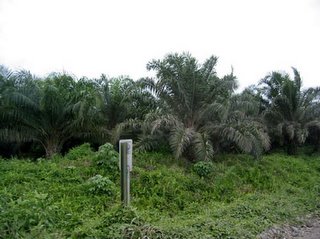Mile After Mile of Oil Palms
On the Pacific Coast road, south of Jaco there is an almost unbroken landscape of oil palm plantations. Palm oil is used in chocolate, bread, potato chips, detergents, cosmetics, sunscreen, margarine, shortening, baked goods, soups, crackers, candies and is used an enormous amount in the fast food industry.

(this picture is from Costa Rica Conservation Trust website)
According to the report Cruel Oil, How Palm Oil Harms Health, Rainforest and Wildlife palm oil is an alternative to oils that are high in trans fat. However it is more conducive to heart disease than olive, soy or canola oil and the World Health Organization is discouraging its use. "If current trends in palm oil consumption continue, that oil’s global impact on public health will increase greatly."
Not only is the oil a health risk, but presents environmental problems too. Reading the report Cruel Oil is a real eye-opener:,
Why do we need junk food? Why do we think we need makeup? Why can't we just get by with less?

According to the report Cruel Oil, How Palm Oil Harms Health, Rainforest and Wildlife palm oil is an alternative to oils that are high in trans fat. However it is more conducive to heart disease than olive, soy or canola oil and the World Health Organization is discouraging its use. "If current trends in palm oil consumption continue, that oil’s global impact on public health will increase greatly."
Not only is the oil a health risk, but presents environmental problems too. Reading the report Cruel Oil is a real eye-opener:,
"Once oil palm has replaced the immense variety of hundreds of species of trees, vines, shrubs, mosses, and other plants found on every acre of lowland rainforest, most animals can no longer live there. An oil palm plantation is, in effect, a “biological desert.” As an industrial plantation crop, oil palm is grown as a monoculture. Most of the other plants found are low-growing ground cover. Without the rainforest’s plenteous variety of fruits, nuts, leaves, roots, nectar, bark, shoots, and other plant materials to eat, most animals cannot survive. And, without plenty of plant-eating prey animals such as deer to hunt, carnivores such as tigers cannot survive either. The plantations provide habitat for only 20 percent or less of the previously resident mammals, reptiles, and birds."
Why do we need junk food? Why do we think we need makeup? Why can't we just get by with less?

0 Comments:
Post a Comment
<< Home